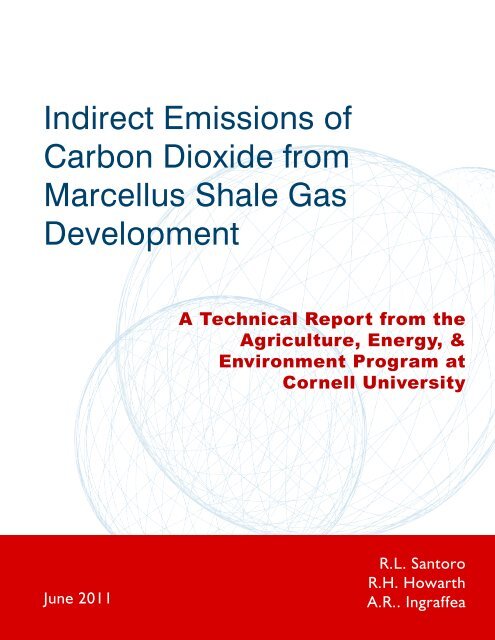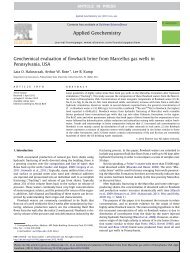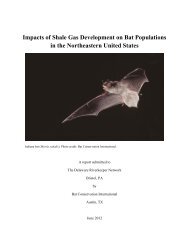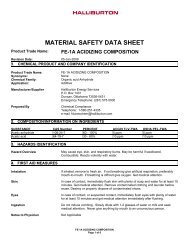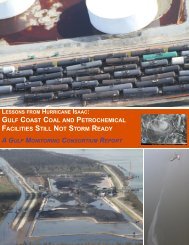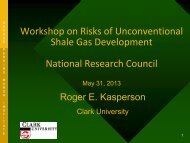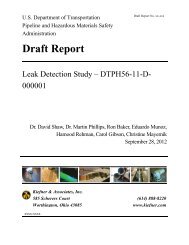Indirect Emissions of Carbon Dioxide from Marcellus Shale Gas ...
Indirect Emissions of Carbon Dioxide from Marcellus Shale Gas ...
Indirect Emissions of Carbon Dioxide from Marcellus Shale Gas ...
You also want an ePaper? Increase the reach of your titles
YUMPU automatically turns print PDFs into web optimized ePapers that Google loves.
<strong>Indirect</strong> <strong>Emissions</strong> <strong>of</strong><br />
<strong>Carbon</strong> <strong>Dioxide</strong> <strong>from</strong><br />
<strong>Marcellus</strong> <strong>Shale</strong> <strong>Gas</strong><br />
Development<br />
A Technical Report <strong>from</strong> the<br />
Agriculture, Energy, &<br />
Environment Program at<br />
Cornell University<br />
June 2011<br />
R.L. Santoro<br />
R.H. Howarth<br />
A.R.. Ingraffea
Copyright©2011<br />
Cornell University holds a non-exclusive copyrights for the contents <strong>of</strong> this book, a copyright shared with<br />
the individual authors. Authors maintain right to reproduce or re-use material <strong>from</strong> this report, or grant the<br />
right to do so to others. Cornell and its agents also maintain a right to reproduce or re-use any portion <strong>of</strong><br />
the report. Re-publication or re-use <strong>of</strong> any portion is prohibited without explicit written authorization <strong>from</strong><br />
the authors or <strong>from</strong> Cornell University. Any re-publication or re-use <strong>of</strong> material should acknowledge this<br />
original publication with full citation. All rights reserved under International and Pan-American Copyright<br />
Conventions. Cornell University, Ithaca, New York, USA.<br />
Citation: Santoro, R.L.; R.W. Howarth; A.R. Ingraffea. 2011. <strong>Indirect</strong> <strong>Emissions</strong> <strong>of</strong> <strong>Carbon</strong> <strong>Dioxide</strong> <strong>from</strong><br />
<strong>Marcellus</strong> <strong>Shale</strong> <strong>Gas</strong> Development. A Technical Report <strong>from</strong> the Agriculture, Energy, & Environment<br />
Program at Cornell University. June 30, 2011<br />
Report is available electronically at: http://www.eeb.cornell.edu/howarth/<strong>Marcellus</strong>.htm<br />
Design and layout: R.L. Santoro
June 30, 2011<br />
Renee L. Santoro 1 , Robert W. Howarth 1 , Anthony R. Ingraffea 2<br />
1. Department <strong>of</strong> Ecology & Evolutionary Biology, Cornell University, Ithaca, NY 14853 USA.<br />
2. School <strong>of</strong> Civil and Environmental Engineering, Cornell University, Ithaca, NY 14853 USA.
ACKNOWLEDGEMENTS<br />
Preparation <strong>of</strong> this report was supported by a grant <strong>from</strong> the Park Foundation, an<br />
endowment fund <strong>of</strong> the David R. Atkinson Pr<strong>of</strong>essorship in Ecology & Environmental<br />
Biology at Cornell University, and the Dwight C. Baum Pr<strong>of</strong>essorship in Civil and<br />
Environmental Engineering at Cornell University. We thank D. Hughes and C.<br />
Costello for their review <strong>of</strong> the manuscript, and B. Sell for useful comments on an<br />
earlier version <strong>of</strong> the report. We further wish to thank G.R. Smith, R. Marino, M.<br />
Carcella, D. Swaney for information, encouragement, advice, and feedback.<br />
i
Summary<br />
<strong>Shale</strong> gas is <strong>of</strong>ten characterized as a bridge fuel to renewable energy in part because a<br />
perception that natural gas has a lower greenhouse gas footprint than other fossil fuels;<br />
however, the actual magnitude <strong>of</strong> greenhouse gas emissions <strong>from</strong> shale gas has received very<br />
little study and the Council <strong>of</strong> Scientific Society Presidents (2010) cautioned that relying on<br />
shale gas might actually aggravate global warming.<br />
The <strong>Marcellus</strong> shale is cited as being one <strong>of</strong> the world’s largest on-shore unconventional natural<br />
gas resources (Fig 1). The northern portions <strong>of</strong> the play have recently experienced a rush <strong>of</strong><br />
development due to spikes in the market value <strong>of</strong> natural gas and advanced drilling and<br />
stimulation technology previously developed in the Barnett shale formation.<br />
In this report, we estimate the emissions <strong>of</strong> carbon dioxide associated with all fuel combustion<br />
associated with the shale gas life-cycle focusing on the <strong>Marcellus</strong> shale as a case study. We<br />
calculate all GHG emissions <strong>from</strong> land clearing, resource consumption, and diesel consumed in<br />
internal-combustion engines (mobile and stationary) during well development. Energy consumed<br />
once the gas well is brought into production (i.e. that consumed in production, processing, and<br />
transmission/distribution streams) are assumed to be similar to previously published estimates;<br />
therefore, we use emission intensities <strong>from</strong> the literature for these sources. Additionally, we do<br />
not address fugitive and vent emissions here. Rather, the reader is directed to our companion<br />
paper (Howarth et al., 2011), which emphasizes the importance <strong>of</strong> methane venting and<br />
leakage, concluding that in fact shale gas has a larger greenhouse gas footprint compared to<br />
other fossil fuels.<br />
We estimate total indirect CO2 emissions as between 1.17 and 1.69 g C MJ -1 (LHV), depending<br />
upon whether or not the raw gas requires processing. Compared to the direct (i.e. end-use<br />
combustion) CO2 emissions: 15 g C MJ -1 (LHV), the indirect emissions are small, but not trivial.<br />
Our estimated indirect CO2 emissions <strong>from</strong> shale gas are 0.04 to 0.45 g C MJ -1 greater than that<br />
reported for conventional gas (Woods et al., 2011). Still, a far greater part <strong>of</strong> the greenhouse<br />
gas footprint <strong>of</strong> shale gas comes <strong>from</strong> methane venting and leakage (Howarth et al., 2011).<br />
ii
Table <strong>of</strong> Contents<br />
Acknowledgements...................................................................................i<br />
Summary.................................................................................................ii<br />
Introduction...........................................................................1<br />
Assumptions & Detailed Methodology......................................4<br />
Well Production...............................................................................................4<br />
Stationary engines...........................................................................................7<br />
Mobile engines................................................................................................9<br />
Resource consumption.....................................................................................9<br />
Steel production.............................................................................................10<br />
Cement production.........................................................................................11<br />
Chemical manufacturing.................................................................................11<br />
Gravel mining.................................................................................................11<br />
Asphalt production.........................................................................................12<br />
Land disturbance...........................................................................................12<br />
Results & Conclusions........................................................... 14<br />
iv
1. Introduction<br />
Conventional gas reserves a are being depleted in both the U.S. and globally, and many view<br />
natural gas <strong>from</strong> shale formations as a replacement over coming decades (DOE/EIA 2010;<br />
Woods et al. 2011), although Hughes (2011) cautions that the resource may not be as large as<br />
is sometimes promoted. This shale gas is <strong>of</strong>ten characterized as a bridge fuel, allowing society<br />
to continue to use fossil fuels over the coming few decades while slowly building towards a path<br />
<strong>of</strong> renewable energy, in part because a perception that natural gas has a lower greenhouse gas<br />
footprint than other fossil fuels. However, the actual magnitude <strong>of</strong> greenhouse gas emissions<br />
<strong>from</strong> shale gas has received very little study, and the Council <strong>of</strong> Scientific Society Presidents<br />
(2010) cautioned that relying on shale gas might actually aggravate global warming. In Howarth<br />
et al. (2011), we estimated the greenhouse gas footprint <strong>of</strong> shale gas, emphasizing the<br />
importance <strong>of</strong> methane venting and leakage, and concluding that in fact shale gas has a large<br />
greenhouse gas footprint compared to other fossil fuels. In this report, we estimate the indirect<br />
emissions <strong>of</strong> carbon dioxide b associated with shale gas development, focusing on the <strong>Marcellus</strong><br />
shale as a case study.<br />
The <strong>Marcellus</strong> shale is cited as being one <strong>of</strong> the world’s largest on-shore unconventional natural<br />
gas resources (Ubinger et al. 2010). The <strong>Marcellus</strong> shale is a Devonian sedimentary rock<br />
formation extending <strong>from</strong> West Virginia to south-central New York and <strong>from</strong> eastern Ohio to<br />
large parts <strong>of</strong> Pennsylvania and small portions <strong>of</strong> Maryland and Virginia. It is estimated to<br />
contain at least 4.64 trillion m 3 (164 tcf; NYDEC 2009) <strong>of</strong> natural gas with some estimates <strong>of</strong><br />
in-place resource as high as 13.8 trillion m 3 (489 tcf; Englender and Lash 2008). Typical<br />
developable depths <strong>of</strong> the shale are 1,524 m near the New York- Pennsylvania border and<br />
increase southward, with thickness ranging <strong>from</strong> 30 – 60 m. Until recently, the gas in-place had<br />
not previously been exploited due to high development costs, a low price for natural gas, and<br />
technological challenges (National Academy <strong>of</strong> Sciences, 2001); however, increased market<br />
value <strong>of</strong> natural gas between 2005 and 2008 (DOE/EIA 2011a) combined with advances in<br />
drilling and stimulation technology proven in the Barnett shale formation - directional drilling<br />
combined with high volume hydraulic fracturing (HVHF) – made the <strong>Marcellus</strong> more economic,<br />
at least for a while, thus starting a rush <strong>of</strong> development in 2007 in some states in the region.<br />
More than 3,000 <strong>Marcellus</strong>-only wells have been drilled within the past 4 years. In 2009, 768<br />
wells, 70% <strong>of</strong> them horizontal, were drilled in Pennsylvania alone (PA DEP, 2010; NETL, 2010)<br />
with an additional 1,386 <strong>Marcellus</strong> wells drilled there in 2010. Note that since 2009, the price <strong>of</strong><br />
natural gas has fallen (DOE/EIA 2011a), and the economics <strong>of</strong> shale gas are being increasingly<br />
questioned (Urbina 2011; Hughes 2011).<br />
The natural gas life-cycle consists <strong>of</strong> three “streams” or segments: upstream, which consists <strong>of</strong><br />
exploration, extraction, and gathering <strong>of</strong> gas; midstream, or the <strong>of</strong>f-site processing <strong>of</strong> raw gas to<br />
meet pipeline specifications; and downstream, or transportation/storage and distribution to<br />
consumers. Both conventional and unconventional gas development follow the same general<br />
path <strong>from</strong> extraction to end-use consumption; however, energy and material inputs in<br />
unconventional gas extraction will be shown here to be higher.<br />
1
Early shale gas development depended on high densities <strong>of</strong> vertical, hydraulically-fractured wells<br />
to help maximize production (NPC, 2007). Early hydraulic fracturing experiments in shale used<br />
gel-fluids, which made the process less water intensive (NPC, 2007). However, the cost and<br />
problems associated with clean up - and the inability to pump high volumes <strong>of</strong> gel-based fluid at<br />
high pressure - proved inhibitory, leading to experimentation with high-volume, slick water<br />
fracturing (NPC, 2007). Modern shale gas recovery relies on directional drilling and multi-stage,<br />
slick-water, HVHF technology. Directional drilling maximizes areal exposure to the formation,<br />
and, thus, production rates <strong>of</strong> the well, by drilling laterally along the formation rather than at a<br />
cross-section as with traditional vertical drilling. Horizontal wells decrease land impacts by<br />
decreasing the number <strong>of</strong> wells required to maximize recovery within a given land area, but<br />
further increase total drilling depth (i.e. vertical depth plus lateral length) and, therefore,<br />
energy inputs and the associated CO2 emissions. Still more energy and materials are required<br />
in the HVHF process, as numerous pumps <strong>of</strong> 1000 hhp or more are required to force frac fluids<br />
down the borehole and into the formation at a high enough pressure to optimally fracture or<br />
re-fracture the rock.<br />
Energy consumed upstream depends largely on the total drilling depth, as well as physical<br />
characteristics (e.g. permeability) <strong>of</strong> the formation. The permeability <strong>of</strong> discrete, conventional<br />
gas deposits is several orders <strong>of</strong> magnitude higher than that <strong>of</strong> shale, where gas is locked in a<br />
complex system <strong>of</strong> micr<strong>of</strong>ractures and existing joint sets over a much larger spatial scale. Thus<br />
shale gas development requires either high-density well spacing, and/or long laterals to<br />
maximize the area <strong>of</strong> extraction, and thereby the volume <strong>of</strong> gas produced <strong>from</strong> a given spatial<br />
extent <strong>of</strong> the matrix. Modern conventional gas wells, while typically vertically drilled, may also<br />
employ directional drilling; however, lateral lengths are substantially shorter than that required<br />
to economically develop a shale gas well. Typical <strong>Marcellus</strong> vertical depths in Pennsylvania are<br />
~ 2 km (ICF, 2009b) with the average lateral extending 1.4 km (NYDEC, 2009).<br />
Well stimulation is another critical difference between conventional and unconventional gas<br />
wells. While modern conventional wells do rely on hydraulic fracturing to stimulate production,<br />
the volume <strong>of</strong> frac fluid consumed is significantly less than that required for a shale gas well. For<br />
one, longer laterals require higher frac fluid volumes and multiple frac stages (typically 1 stage<br />
for about every 100 m <strong>of</strong> lateral), in which sections <strong>of</strong> the lateral are sequentially plugged,<br />
perforated, and fraced. Conventional and vertical wells are generally completed in a single or a<br />
few stages due to lack <strong>of</strong>, or minimal extent <strong>of</strong>, the lateral. New York state regulations limit the<br />
volume <strong>of</strong> frac fluid used in conventional wells to 300 thousand liters (80,000 gal; NYDEC,<br />
2009); shale gas wells consume on average 20 million liters (2.4 – 7.8 million gallons; NYDEC,<br />
2009), or a volume 2 orders <strong>of</strong> magnitude greater.<br />
A full life-cycle accounting <strong>of</strong> GHG emissions (CO2, CH4, N2O) associated with the natural gas<br />
industry must include those emissions associated with direct (i.e. end-use) combustion <strong>of</strong> the<br />
natural gas, as well as all indirect emissions associated with the fossil fuels consumed and<br />
fugitive losses incurred throughout the streams <strong>of</strong> the lifecycle, including stationary (e.g. rigs)<br />
and mobile (e.g. truck transport <strong>of</strong> equipment and wastes) diesel engines, land-use change, and<br />
resource (e.g. steel, cement, organic chemicals, etc.) consumption.<br />
2
<strong>Emissions</strong> may be calculated by various methods depending on the data available, although<br />
uncertainty increases inversely with data requirements. Direct, long-term measurement is<br />
potentially the most robust c , but requires location-specific fuel consumption and activity data,<br />
which are <strong>of</strong>ten not publicly available and make the method impractical over spatial scales<br />
larger than a single plant/operation. Alternatively, published emission factors (EF) may be used.<br />
These generally represent an average rate <strong>of</strong> emission for a specific source or activity, but the<br />
associated uncertainty <strong>of</strong> non-CO2, non-combustion EFs are generally high d (±25% to more<br />
than 200%; Shires et al., 2009), as they depend on the representativeness and accuracy <strong>of</strong> the<br />
input data used to derive them. Additional uncertainty may result <strong>from</strong> the choice <strong>of</strong> activity<br />
factors (AF) or assumptions about fuel characteristics in the emissions calculation. In the<br />
absence <strong>of</strong> available EFs, engineering calculations, though sensitive to simplifying assumptions<br />
and sometimes data intensive, are recommended (Shires et al., 2009).<br />
Most <strong>of</strong> the carbon dioxide emissions associated with natural gas development are related to<br />
combustion <strong>of</strong> fossil fuels, either the end product (burned by market consumers) or other fuels<br />
used to run drilling engines, compressors, generators, etc. Thus, fuel properties are important<br />
parameters in the emissions inventory. Heating value, the energy released in full combustion,<br />
can vary by fuel type and specific fuel composition, i.e. the proportions <strong>of</strong> individual carboncontaining<br />
components. Published heating values reflect typical compositions <strong>of</strong> fuel types and<br />
are reported in both high (HHV) and low (LHV) heating values. HHV accounts for condensation<br />
<strong>of</strong> water during combustion; water is considered in the vapor phase in LHV reported values.<br />
U.S. data are commonly reported in HHV, while the IPCC (2007) and international sources<br />
report using LHV. We used LHV in Howarth et al. (2011). Use <strong>of</strong> either HHV or LHV is a<br />
matter <strong>of</strong> convention and the choice <strong>of</strong> either does not impact the emissions inventory,<br />
provided that both energy values and emission factors reflect the same convention<br />
(Shires et al., 2009). We report HHV and LHV emissions for all sources.<br />
3
2. Assumptions & Detailed Methodology<br />
We calculate the upstream GHG emissions associated with developing and producing gas <strong>from</strong><br />
a representative <strong>Marcellus</strong> well e . Specifications for well and casing design (Table 2.1) are taken<br />
<strong>from</strong> a permit application representative <strong>of</strong> the industry requests received to date by Broome<br />
County, NY (L. Collart, NYSDEC Reg 7,<br />
). The inventory uses EFs and default<br />
engine efficiencies as reported in the API Compendium <strong>of</strong> Greenhouse <strong>Gas</strong> <strong>Emissions</strong><br />
Methodologies for the Oil and Natural <strong>Gas</strong> Industry (Shires et al., 2009) for all upstream<br />
internal combustion (IC) engine sources. <strong>Indirect</strong> emissions are calculated using specific EFs<br />
for the industry <strong>of</strong> interest. Table 2.2 lists the emission factors used in this inventory.<br />
<strong>Gas</strong> recovered in the northeastern portion <strong>of</strong> the <strong>Marcellus</strong> play is expected to be low in sulfur<br />
compounds (i.e. sweet), with high methane content, and dry (i.e. "pipeline ready") and will not<br />
Table 2.1 Well Specifications for a representative<br />
<strong>Marcellus</strong> shale gas well, Broome County, NY<br />
(Source: Chesapeake 2009).<br />
Total Drilling<br />
Depth<br />
4<br />
8785 ft 2678 m<br />
Lateral Length 3938 ft 1200 m<br />
BHP 5000 psi 340.2 atm<br />
BHT 250 F 121 C<br />
Casing Detail<br />
d (in) L (ft) Wt<br />
(lb)<br />
Conductor 16 60<br />
Grade<br />
Surface 9.625 1000 40 J-55<br />
Production 5.5 8785 40 P-110<br />
Cement Detail<br />
Grade<br />
ID<br />
(in)<br />
OD<br />
(in)<br />
% excess<br />
Cond-Surface Class A 16 9.625 100<br />
Surface-Prod<br />
inhibited<br />
9.625 5.5 15<br />
require processing. However, wet gas<br />
production has been reported in the<br />
southwestern portion <strong>of</strong> the play. We<br />
therefore provide both no-processing<br />
and processing scenarios.<br />
Post drill/completion activities for<br />
<strong>Marcellus</strong> gas will not differ <strong>from</strong> that<br />
<strong>of</strong> conventional natural gas aside <strong>from</strong><br />
the need to construct new gathering<br />
lines and drilling and stimulation <strong>of</strong> new<br />
or increased capacity underground<br />
storage facilities. Emission estimates<br />
related to pipeline construction are<br />
detailed below. At this time, we do not<br />
have adequate information with which<br />
to calculate emissions related to<br />
activities to increase regional storage<br />
capacity f . <strong>Indirect</strong> emissions <strong>from</strong><br />
production, processing and transmission<br />
/distribution stages are calculated based<br />
on literature values (ARI/ICF, 2008;<br />
Armendariz, 2009).<br />
Well drilling, stimulation, and<br />
completion <strong>of</strong> the well are not continuous emission sources over the lifetime <strong>of</strong> the well and<br />
need to be allocated over the time between drilling and any re-working <strong>of</strong> the well. Here, we<br />
assume a 10-year life <strong>of</strong> the well (NYDEC, 2009) during which time the original well completion<br />
is assumed to be the only time that the well undergoes hydraulic fracturing. After 10 years, well<br />
production is expected to drop below that which is marginally economic and the well will
Table 2.2. Emission Factors (EF). Combustion EFs are taken <strong>from</strong> Shires et al (2009). Sources for land use<br />
change and resource consumption are as noted in the table.<br />
Source category<br />
Original Units G C basis<br />
Reference CO2 EF Units CO2 EF Units<br />
Diesel fuel IPCC, 2007 table 1.3 20.2 Kg C GJ-1 (LHV) 1.92E-05 g C J-1 (HHV)<br />
Natural gas (pipelineready)<br />
EPA, 2008 14.47 Kg C MMBtu-1 1.37E-05 g C J-1 (HHV)<br />
Cement Hanle, 2004 0.97 tCO2 t-1 2.65E+05 g C tonne-1<br />
Steel US Steel, 2009 1.14 tCO2 t-1 3.25E+05<br />
g C tonne-1<br />
Gravel EPA, 2003 0.0025 MTCE t-1 1.26E+03<br />
g C tonne-1<br />
US Org chem.<br />
Ozalp & Hyman,<br />
2002<br />
1.43 tonnes CO2 tonne-1 3.91E+05<br />
g C tonne-1<br />
Asphalt<br />
Chehovits&<br />
Galehouse, 2010<br />
8.5 - 13.1 Kg m2-1 2.32E+03 - 3.58E+03 g C tonne-1<br />
Land clearing Tyner et al., 2010 167.5 tonne CO2 ha-1 4.57E+07 g C ha-1<br />
Foregone C<br />
seqestration.<br />
Tyner et al., 2010 12.38 Tonne CO2 ha-1 9.38E+03 g C ha-1 mth-1<br />
5
equire additional fracturing to boost production. Emission intensities for upstream activities<br />
are therefore calculated using the predicted 10-yr production <strong>of</strong> the well. We note, however,<br />
that the Barnett experience indicates that wells may require earlier re-stimulation (ICF, 2009a);<br />
in this case the emission intensities would be expected to be greater than those reported here.<br />
Predicting production rates for a play so early in development is difficult, as data particular to<br />
the northeastern Pennsylvania <strong>Marcellus</strong> play, where our representative well is located, is<br />
limited and recoverable resources vary widely across shale formations and even within a<br />
particular formation. We start with wellhead production estimates taken <strong>from</strong> industry reports<br />
(Engelder 2009) on projected 5-year cumulative production per well for the <strong>Marcellus</strong> play<br />
(8.8 million m 3 yr -1 ). Berman (2009) concludes that industry has over-estimated potential<br />
production for many <strong>of</strong> the U.S. plays citing the differences between initial Barnett shale g<br />
predictions and reported well production over time. See also Hughes (2011). We have<br />
therefore compared the industry-reported <strong>Marcellus</strong> production estimates to reported 2009<br />
Table 2.3 Wellhead Production and Life-Cycle Losses<br />
for a representative <strong>Marcellus</strong> shale gas well.<br />
GROSS (casinghd) cf m 3 MJ<br />
LOSSES<br />
5 yr cumm a 1.55E+09 4.39E+07 1.67E+09<br />
5 yr annual avg 3.10E+08 8.78E+06 3.34E+08<br />
10 yr annual 2.07E+08 5.85E+06 2.22E+08<br />
avg b<br />
10 yr cumm 2.07E+09 5.85E+07 2.22E+09<br />
1.9% completion c 3.93E+07 1.11E+06 4.23E+07<br />
1.1% production c 2.27E+07 6.44E+05 2.45E+07<br />
0.19% processing c 3.93E+06 1.11E+05 4.23E+06<br />
2.5% Trans/dist c 5.17E+07 1.46E+06 5.56E+07<br />
Lease + pipe 3.37E+07 9.54E+05 3.63E+07<br />
fuel d<br />
Plant fuel d 8.93E+06 2.53E+05 9.61E+06<br />
Sum losses NO PROC 1.47E+08 4.17E+06 1.59E+08<br />
Sum losses PROC 1.60E+08 4.54E+06 1.72E+08<br />
10 yr NET (no proc) 1.92E+09 5.43E+07 2.07E+09<br />
10 yr NET (proc) 1.91E+09 5.40E+07 2.05E+09<br />
a Engelder 2009<br />
b 5 y production is extended to the assumed 10 y life <strong>of</strong> the well by<br />
reducing cumulative production by a third.<br />
c median reported values <strong>from</strong> Howarth et al 2011<br />
d long-term average for US domestic gas as reported by EIA 2011<br />
and 2010 production for wells in<br />
Susquehanna County, PA (PADEP,<br />
2010), assuming exponential<br />
decline curves. Given (limited)<br />
data currently available, we find<br />
the industry prediction is<br />
reasonable and base our well<br />
production on it. To adjust the<br />
5-yr cumulative production to our<br />
10-yr life <strong>of</strong> the well, we assume<br />
an additional reduction <strong>of</strong> 1/3<br />
based on the decline curve,<br />
yielding 58.5 million m 3 cumulative<br />
production over 10 yrs.<br />
However, cumulative wellhead<br />
production does not represent<br />
the energy available to end-users,<br />
as losses are incurred throughout<br />
the lifecycle; net production, or<br />
the balance between wellhead<br />
production and the total volume<br />
lost to fugitive/vent emissions and<br />
gas consumed as fuel enroute to<br />
consumers, is more appropriate.<br />
We therefore adjust wellhead<br />
production by subtracting the<br />
median fugitive methane losses<br />
reported in Howarth et al (2011)<br />
and lease, plant and pipeline gas<br />
consumed (average <strong>of</strong> US data<br />
2000-2010 as reported by EIA,<br />
6
2011). Table 2.3 provides a detailed accounting <strong>of</strong> the gross and net energy per well.<br />
All gas conversions <strong>from</strong> volumetric to mass basis assume API standard conditions (1 atm and<br />
288.75 K; Shires et al., 2009). <strong>Gas</strong> density is assumed to be 42.2 moles m -3 at these conditions.<br />
All combustion emissions assume 100% oxidation.<br />
Upstream energy inputs for stationary combustion are estimated <strong>from</strong> the energy output<br />
(hp-hr/yr) <strong>of</strong> the various engines onsite. The largest <strong>of</strong> these engines are the prime-mover -<br />
the drilling rig's main power source - and the frac pumps. Estimated power required to run the<br />
drawworks is a function <strong>of</strong> total borehole depth with 10 hp required for every 30.5 m (Nguyen<br />
1996), or a minimum power requirement <strong>of</strong> 880 hp for our <strong>Marcellus</strong> well. Industry sources<br />
report that the ideal and most commonly used rig in <strong>Marcellus</strong> drilling is a 1000 hp unit<br />
(NYDEC,2009; Rigzone, 2010), though completion rigs maybe significantly smaller. We assume<br />
a 1000 hp rig running at 50% for both drilling and completion. Frac pump hydraulic horse<br />
power (hhp) is a function <strong>of</strong> the injection rate (bpm) and surface treating pressure (psi).<br />
Typical <strong>Marcellus</strong> injection rates range <strong>from</strong> 30-71 bpm and with expected pressure ranges <strong>of</strong><br />
5,000 - 10,000 psi (NYDEC, 2009). Taking the average <strong>of</strong> each range, the minimum required<br />
hhp is 9283 hhp ((bpm x psi)/40.8), which we have rounded up to 9300 hhp. Smaller auxiliary<br />
engines are also needed to run mud and cement pumps, air supply, and generators that supply<br />
electricity to the doghouse and other onsite buildings. A detailed list <strong>of</strong> drilling, completion, and<br />
mobile engines is provided in Table 2.5.<br />
<strong>Emissions</strong> for stationary drilling and completion engines are calculated <strong>from</strong> equation 1. For our<br />
well, all drilling-process engines are assumed to run at 50% load, 24 hrs/d, for 4 weeks, the low<br />
end estimate reported by NYDEC (2009). Frac pumps are assumed to run for an average <strong>of</strong> 70<br />
hr (NYDEC, 2009) at 100% load (to meet calculated hhp requirements). All engines are<br />
assumed to run on diesel fuel and power output is converted to power input using a default<br />
thermal efficiency factor <strong>of</strong> 3179 Jin/Jout for diesel IC engines (Shires et al., 2009).<br />
Eq 1.<br />
Ei = (ER * LF * OT * ETT) *EF<br />
where:<br />
Ei = g C emissions <strong>of</strong> species i<br />
ER = equipment rating in hp<br />
LF = fractional load factor<br />
OT = operating time in hr well life -1<br />
ETT = Equipment thermal efficiency in J input hp-hr output -1<br />
Combustion emissions associated with other streams (i.e. production, processing, and<br />
transmission/distribution) in the life-cycle are difficult to estimate without details <strong>of</strong> site<br />
equipment and/or fuel usage data. We therefore rely on emission rates <strong>from</strong> the literature.<br />
ARI/ICF (2008) assessed the life-cycle GHG inventory <strong>of</strong> US domestic natural gas and LNG<br />
imports and indicate combustion emissions <strong>of</strong> 0.58, 0.49, and 0.15 g C MJ -1 (assuming 2006 US<br />
7
Table 2.4 Internal Combustion Engines at Well Site, Activity Data a<br />
Stationary<br />
Combustion<br />
no. hp load hr/ye<br />
ar b<br />
Drilling 1 Prime mover/drawworks (1000 hp) 1000 0.50 672<br />
2 Mud pumps (750 hp each) 1500 0.5 673<br />
1 Generators (1200hp) 1200 1.5 674<br />
2 Air package (30hp) 60 2.5 675<br />
1 Cement pump (750hp, 9.5 bpm max cap 750 3.5 676<br />
@ 2650 psi)<br />
Stimulation n/a Pumps (50.5bpm, 7500 psi: min hhp = 9300 1.00 70<br />
9283.1)<br />
1 Generators (1200hp) 1200 5.5 70<br />
Mobile Combustion truc load # trips<br />
Equipment trucks TOTAL 280 0.5 2<br />
Drill pad & road construction 45 1.5 3<br />
Drilling rig 30 2.5 4<br />
Drilling equip 50 3.5 5<br />
Completion equip 5 4.5 6<br />
Fracture stimulation equip 150 5.5 7<br />
Fluids trucks TOTAL 650 6.5 8<br />
Water trucks 440 7.5 9<br />
Chemical trucks 5 8.5 10<br />
Flowback trucks 190 9.5 11<br />
Production water trucks 15 10.5 12<br />
Site clearing<br />
Joules per ha<br />
mobile<br />
combustion c<br />
Bulldozers (grading purpose; 335 net hp) 1.24E+12<br />
large excavator (mid-level: 159 net hp) 9.77E+10<br />
a All engines are assumed to run on diesel fuel.<br />
b Drilling activity is expected to last 4 weeks with engines running 24 hr d -1 ; Fracturing time is<br />
expected to last <strong>from</strong> 40 to 100 hours per well depending on well and geologic characteristics<br />
(NYDEC, 2009); we use the average <strong>of</strong> 70 hours as a conservative estimate <strong>of</strong> pump engine<br />
time.<br />
c Earth moving equipment input is estimated assuming 6 grading dozers and 1 large excavator<br />
employed in clearing the well site over 3 days at 12 hr d -1 . Energy input is then divided by the<br />
number <strong>of</strong> hectares cleared to convert energy input to a per hectare basis. Earth moving<br />
emissions are estimated separately for each category (pad, access road, or pipeline) assuming<br />
the area cleared and machinery used in clearing (see text).<br />
8
domestic supply; DOE/EIA, 2011b) for production, processing, and transmission/distribution<br />
streams, respectively. Armendariz (2009) combined all compressor emissions in the Barnett<br />
shale as a single emission term (compressors are considered the only significant combustion<br />
emission source in the production and transmission streams) indicating a combined emission<br />
intensity <strong>of</strong> 0.69 g C MJ -1 for production and transmission; assuming a similar distribution <strong>of</strong><br />
emissions as reported in ARI/ICF (2008), 80% <strong>of</strong> this can be attributed to the production<br />
stream (0.54 g C MJ -1 ) with the remainder (0.14 g C MJ -1 ) attributed to transmission engines.<br />
Here, we use the average <strong>of</strong> the two studies for reporting production and transmission<br />
emissions (0.56 g C MJ -1 and 0.15 g C MJ -1 , respectively). Only ARI/ICF (2008) reported<br />
processing emissions <strong>from</strong> combustion <strong>of</strong> plant gas; we use their value <strong>of</strong> 0.49 g C MJ -1 .<br />
The numerous trucks and tankers needed to transport drilling and frac equipment, resources<br />
and waste products to and <strong>from</strong> the well site make up the mobile source category. Moss (2008)<br />
estimates 280 truckloads are required to transport drilling and completion equipment. Assuming<br />
a maximum load <strong>of</strong> 7,000 gal per truckload, we estimate an additional 1,069 truckloads are<br />
required to transport fresh water, fracing chemicals, and wastes.<br />
<strong>Emissions</strong> <strong>from</strong> mobile internal combustion engines are calculated <strong>from</strong> equation 2. Truckloads<br />
are doubled and a 50% load is assumed to account for roundtrips. Estimated mobile source<br />
combustion estimates assume a default fuel economy factor <strong>of</strong> 0.161 gallons/mile for articulated<br />
diesel trucks (Shires et al., 2009). We assume average distances <strong>of</strong> 200 miles/truckload for<br />
drilling and completion equipment and an average <strong>of</strong> 125 miles/truckload for water, chemicals,<br />
and wastes. PADEP data <strong>from</strong> 2010 show recycling at about 40% <strong>of</strong> water brought to a well<br />
industry wide. We have therefore reduced water and waste truckload by 40%.<br />
Eq 2.<br />
Ei = (load * 2 * FE * diesel HHV) * EF<br />
where:<br />
Load=the number <strong>of</strong> trucks required to transport a given volume <strong>of</strong><br />
resources or equipment<br />
FE = default fuel economy<br />
Fuel HHV is expressed as J gal -1 assuming standard fuel density<br />
In addition to consumption <strong>of</strong> diesel fuel, on-shore gas extraction consumes various<br />
manufactures and other resources - i.e. steel, cement, and gravel, as well as land resources -<br />
each <strong>of</strong> which have additional GHG emissions associated with them. <strong>Marcellus</strong> shale gas<br />
development additionally consumes large quantities <strong>of</strong> organic chemicals for use in fracturing<br />
fluids and hot mix asphalt for upgrading local roads which were not designed for high volume,<br />
heavy truck and tanker traffic.<br />
9
Emission intensities for material resources consumed in preparing and developing the well site<br />
are generally given on a per mass or volume basis. Emission factors for the consumables<br />
considered here are given as g C-CO2 tonne -1 , thus total emissions <strong>from</strong> resource consumption<br />
is simply a product <strong>of</strong> the EF and tonnage <strong>of</strong> resource consumed. We provide the calculations<br />
for estimating resource tonnage below.<br />
- Steel consumption per well accounts only for steel tubing used in surface and<br />
production casings (conductor casing is not included because it is such a small percentage <strong>of</strong><br />
total casing volume) and the fraction <strong>of</strong> gathering pipeline attributed to an individual well. Steel<br />
resources used in drilling masts and other heavy equipment is not included, as these uses<br />
continue <strong>from</strong> well site to well site and are not considered 'consumed'.<br />
Eq 3.<br />
T = ppf * L * tonne<br />
lb<br />
Where:<br />
T = tonnes <strong>of</strong> steel<br />
ppf = pounds per foot<br />
L = length <strong>of</strong> pipe<br />
Eq 4.<br />
ppf = F * 10.68 * T * (OD-T)<br />
where<br />
F = relative weight factor adjusted to MAOP h<br />
(default U.S. Steel ~ 1)<br />
T = nominal wall thickness in inches<br />
OD = nominal outside diameter in inches<br />
Steel tonnes required for well casings and gathering pipeline is calculated <strong>from</strong> the weight <strong>of</strong><br />
steel (ppf) and total length <strong>of</strong> the pipe (Eq 3). Weight <strong>of</strong> casing tube steel is reported in the<br />
casing design (Table 2). The mass <strong>of</strong> steel consumed in construction <strong>of</strong> the recently proposed<br />
Laser gathering line is estimated using equation 4 and assuming 52.32 ppf and a total <strong>of</strong> 3.38 km<br />
<strong>of</strong> pipeline (Laser 2010). Steel tonnage consumed over the entire pipeline is then adjusted to a<br />
per well basis assuming the current number <strong>of</strong> wells connected.<br />
If New York State lifts its moratorium on HVHF drilling, the number <strong>of</strong> wells connected to the<br />
gathering line will undoubtedly rise, although additional connections will also require additional<br />
piping. Emission intensity (tonnes CO2 tonne -1 steel) for steel manufacturing is taken <strong>from</strong><br />
recent industry reported values (AISI, 2009).<br />
– Cement consumed is limited to that used in sealing the conductor, surface<br />
and production casings. We calculate the mass <strong>of</strong> portland cement used in stabilizing well<br />
casings based on the annular volumes <strong>of</strong> the casings as suggested by the well specifications (Eq<br />
10
5; Table 2.1). Emission intensity for U.S. cement manufacturing is taken <strong>from</strong> Hanle et al.<br />
(2004).<br />
Eq 5.<br />
T = ∑[( 5.615 cf * ACi * L1 ) * Ei] * tonne<br />
bbl<br />
lb<br />
yield<br />
where:<br />
T = tonnes <strong>of</strong> portland cement<br />
AC = annular capacity <strong>of</strong> casing string i expressed as bbl ft -1<br />
L = length <strong>of</strong> the casing string i in feet<br />
E = percent excess for casing string i expressed as a fraction<br />
yield = cf <strong>of</strong> cement per 94 lb sack<br />
– Fracing chemical tonnage is estimated based on the expected volume<br />
<strong>of</strong> water consumption and mass ratio <strong>of</strong> chemicals consumed in the frac fluid relative to water<br />
(Eq 6). The <strong>Marcellus</strong> wells are expected to consume a total water volume 19.3 x 10 6 L with<br />
0.5% chemicals added to the fluid on a mass basis (NYDEC 2009). Thus, we assume 96 tonnes<br />
<strong>of</strong> chemicals are consumed per well. Emission intensity (tonne CO2 tonne -1 production) for the<br />
U.S. organic chemical industry is taken <strong>from</strong> Ozalp and Hyman (2009).<br />
Eq 6. T = (H2O * Fc) / 2204.6<br />
where<br />
T = total tonnes <strong>of</strong> chemical<br />
Fc = mass fraction <strong>of</strong> chemical compound in fluid<br />
H2O = lbs <strong>of</strong> water consumed<br />
- The well pad and access road to the pad require several thousand tonnes <strong>of</strong><br />
gravel to provide substrate and help control dust. Tonnes gravel consumed is estimated <strong>from</strong><br />
total area and density <strong>of</strong> the aggregate (Eq 7). For both the pad and road we assume a thickness<br />
<strong>of</strong> 0.305 m and a mass <strong>of</strong> 1.365 tonne per cubic yard (t cyd -1 ). The well pad is assumed to have<br />
a land area <strong>of</strong> 2 ha (NYDEC, 2009). We use the NY DEC (2009) estimated land area for the<br />
access road (1609 x 9 meters). The calculated tonnage is then converted to a per well basis<br />
assuming 8 wells per pad. <strong>Emissions</strong> <strong>from</strong> gravel production are estimated at 1.26E3 g C-CO2<br />
tonne -1 (EPA 2003).<br />
11
Eq 7.<br />
T = L * W * D * cyd * d<br />
cf<br />
Where<br />
T = tonnes gravel (virgin aggragate)<br />
L = length <strong>of</strong> the plot in feet<br />
W = width <strong>of</strong> the plot in feet<br />
D = depth <strong>of</strong> gravel cover in feet<br />
d = density <strong>of</strong> the aggregate expressed as tonnes<br />
- Most <strong>of</strong> the roads in counties where shale gas development is expected to<br />
be greatest are not constructed to handle the increased loading and traffic counts that are<br />
expected, resulting in substantial road damage. Damage is expected to be exacerbated by<br />
seasonal freeze/thaw cycles which may lead to roads so damaged that they are not passable.<br />
To address these concerns, counties in the already developed areas <strong>of</strong> the play have bonded<br />
roads used by the gas industry. Under such contracts, gas development companies agree to<br />
upgrade the roads they use to withstand the heavy truck traffic or pay for any excess repairs<br />
over normal maintenance. Pennsylvania DOT (2010) reports 1360 km <strong>of</strong> bonded road<br />
throughout Lackawanna, Luzerne. Pike, Susquehanna, Wayne, and Wyoming counties. Total<br />
<strong>Marcellus</strong> well count for these counties in 2010 is 159 (PA DEP 2010), yielding an estimated<br />
road area <strong>of</strong> 8553 x 9 meter per well.<br />
Emission factors range <strong>from</strong> 2,265 g C-CO2 m -2 for repaving with hot in-place recycling (HIR)<br />
to 3,575 g C-CO2 m -2 for new road construction (Chehovits and Galehouse, 2010). Our<br />
calculations assume the mid-level option <strong>of</strong> repaving using hot mixed asphalt (HMA) with an<br />
emission factor <strong>of</strong> 2,320 g C-CO2 m -2 (Chehovits and Galehouse 2010).<br />
We do not account for a number <strong>of</strong> other consumables such as pad<br />
liners, waste pit liners, spill absorbing materials, etc.<br />
– <strong>Emissions</strong> related to land clearing for a well pad, access road, and gathering line<br />
construction include both initial carbon loss and forgone carbon sequestration. Not all <strong>of</strong> these<br />
land clearing activities, however, will stay cleared for the same length <strong>of</strong> time. For example, 2/3<br />
<strong>of</strong> the well pad might be reseeded within 9 months (1 month per well at 8 wells per pad) <strong>of</strong> the<br />
start <strong>of</strong> drilling and allowed to return to a nearly original state. The area surrounding gathering<br />
lines will also be reseeded, but the land will need to remain treeless to protect the buried lines.<br />
Annual grassland carbon uptakes are low (< 0.002 g C ha -1 ; Soussana et al., 2009); therefore,<br />
we have assumed no reclamation for pipeline land area. Access roads are expected to remain as<br />
roads (e.g. no restoration).<br />
We assume 2 ha <strong>of</strong> disturbance per well pad (Moss, 2008), and 0.44 ha for the access road (477<br />
x 9 meters). The area required for gathering line construction includes 1609 meters <strong>of</strong> pipe per<br />
well pad and adequate width to allow machinery access to the site during construction (15<br />
12
meters), or 2.46 ha. Total disturbance is ~5 ha per site, or 0.62 ha per well. The NYDEC<br />
(2009) estimates total disturbance in the range <strong>of</strong> 1.66 - 3.3 ha per multi-well site not including<br />
gathering lines.<br />
Direct carbon loss and forgone carbon sequestration are estimated <strong>from</strong> area (ha) per well (Eq<br />
8) assuming 8 wells per pad and accounting for the varying time frames <strong>of</strong> land disturbance and<br />
regrowth.<br />
Eq 8.<br />
E = (A*EFloss) + (A*EFseq*t)<br />
where:<br />
E = <strong>Emissions</strong> <strong>of</strong> CO2 (g C /well)<br />
A = Area <strong>of</strong> land per well (ha)<br />
EFloss = Emission Factor for terrestrial CO2 emissions<br />
resulting <strong>from</strong> disturbance (g C/ha)<br />
EFseq = Forgone sequestration <strong>of</strong> CO2 resulting <strong>from</strong> land<br />
disturbance (g C/ha/month)<br />
We also account for combustion emissions associated with the machinery required to clear the<br />
land. We assume 1,235 GJ ha -1 required for grading bulldozers and 98 GJ ha -1 for excavators.<br />
Pad and access road is assumed to employ both excavator and dozers, while the pipeline is<br />
assumed to make use <strong>of</strong> excavators only.<br />
13
3. Results & Conclusions<br />
Table 3. <strong>Emissions</strong> <strong>of</strong> carbon dioxide <strong>from</strong> developing shale gas, including<br />
both indirect emissions and end use combustion<br />
HHV LHV<br />
g C-CO2 MJ -1<br />
Land disturb. & resources consumed 0.16 0.17<br />
disturbance 0.01 0.01<br />
Land clearing
Endnotes<br />
a. The use <strong>of</strong> "unconventional" to describe a gas resource is open to interpretation; as technology advances<br />
and discrete reservoirs become limited, the reserves considered "unconventional" a few decades<br />
ago are more commonly viewed as conventional by modern standards. In this paper, "conventional "<br />
refers specifically to discrete reservoirs <strong>of</strong> associated or unassociated natural gas and "unconventional"<br />
refers to tight-gas formations.<br />
b. Note that the definitions <strong>of</strong> direct and indirect emissions here are consistent with Howarth et al.<br />
(2011) but differ <strong>from</strong> the API definitions (Shires et al 2009).<br />
c. Accuracy <strong>of</strong> direct measurement is dependent on the compatibility <strong>of</strong> monitoring frequency and timing<br />
<strong>of</strong> emission source activity (Shires et al., 2009)<br />
d. CO2 emission factors are constrained by fuel characteristics; therefore uncertainty in country-level<br />
EFs is generally below ±5% (IPCC 2007)<br />
e. Unconventional gas pads in shales may include as many as 16 wells, though NYDEC (2009) reports<br />
6-8 as more common. We assume 8 wells per pad when allocating well pad emissions to an individual<br />
well.<br />
f. New multi-turn storage is expected to require HVHF <strong>of</strong> abandoned wells (as done in developing the<br />
Stage Coach storage facility in Owego, NY) if natural gas is to replace a significant portion <strong>of</strong> coal use<br />
in the electricity generation sector (Aspen Environmental Group, 2010).<br />
g.The Barnett shale in the Fort Worth region <strong>of</strong> Texas is the oldest and most highly developed example<br />
<strong>of</strong> HVHF gas extraction in the U.S. and has the benefit <strong>of</strong> relatively long-term production and well data.<br />
h. MAOP = maximum allowable operating pressure<br />
15
References<br />
AISI (American Iron and Steel Institute). 2009. Steel industry reaches new milestone in energy<br />
efficiency. Press release, January 14, 2009.<br />
http://www.uss.com/corp/environment/documents/Steel%20Industry%20Reaches%20New%20<br />
Milestone%20In%20Energy%20Efficiency.pdf<br />
Armendariz, A. 2009. <strong>Emissions</strong> <strong>from</strong> Natural <strong>Gas</strong> Production in the Barnett <strong>Shale</strong> Area and<br />
Opportunities for Cost-Effective Improvements. Report prepared for Environmental Defense<br />
Fund, Austin TX. 45 pages<br />
ARI/ICF (Advanced Resources International Inc./ICF International). 2008. Greenhouse gas life-cycle<br />
emissions study: Fuel Life-Cycle <strong>of</strong> U.S. Natural <strong>Gas</strong> Supplies and International LNG. Report<br />
prepared for Sempra LNG. Nov 10 2008.<br />
Aspen Environmental Group. 2010. Implications <strong>of</strong> Greater on Natural <strong>Gas</strong> for Electricity Generation.<br />
Report prepared for American Public Power Association. July 2010.<br />
Berman, A. 2009. A time for critical thinking. Presentation. ASPO International Peak Oil Conference<br />
Oct. 11-13, 2009, Denver CO.<br />
Chehovits, J and Galehouse, L. 2010. Energy usage and greenhouse gas emissions <strong>of</strong> pavement<br />
preservation processes for asphalt concrete pavements. In Compendium <strong>of</strong> Papers <strong>from</strong> the<br />
First International Conference on Pavement Construction Materials. First International<br />
Conference on Pavement Preservation, Newport Beach CA Apr. 13 – 15 2010<br />
Chesapeake Energy. 2009. Permit application for well Stiles 1-2H, Broome County NY.<br />
Council <strong>of</strong> Scientific Society Presidents (2010). Letter <strong>from</strong> the Council to President Obama and senior<br />
administration <strong>of</strong>ficials, dated May 4, 2008. Council <strong>of</strong> Scientific Society Presidents, 1155 16th<br />
Avenue NW, Washington, DC 20036. Available at<br />
http://www.eeb.cornell.edu/howarth/CCSP%20letter%20on%20energy%20&%20environment.<br />
pdf<br />
DOE/EIA (U.S. Department <strong>of</strong> Energy/Energy Information Administration). 2010. Annual Energy<br />
Outlook 2011 Early Release Overview. DOE/EIA-0383ER(2011). Energy Information Agency,<br />
U.S. Department <strong>of</strong> Energy. http://www.eia.gov/forecasts/aeo/pdf/0383er(2011).pdf<br />
DOE/EIA (U.S. Department <strong>of</strong> Energy/Energy Information Administration). 2011a. Monthly U.S. natural<br />
gas wellhead price. http://www.eia.gov/dnav/ng/hist/n9190us3m.htm<br />
DOE/EIA (U.S. Department <strong>of</strong> Energy/Energy Information Administration). 2011b. Natural <strong>Gas</strong>, U.S.<br />
Data. http://www.eia.doe.gov/oil_gas/natural_gas/info_glance/natural_gas.html<br />
Engelder, T and Lash, GG. 2008. <strong>Marcellus</strong> <strong>Shale</strong> Play’s Vast Resource Potential<br />
Creating Stir in Appalachia. The American Oil & <strong>Gas</strong> Reporter, May 2008.<br />
Engelder, T. 2009. <strong>Marcellus</strong> 2008: Report card on the breakout year for gas production in the<br />
Appalachian Basin. Fort Worth Basin Oil & <strong>Gas</strong>. Aug, 2009.<br />
EPA (U.S. Environmental Protection Agency). 2003. Background Document for Life-Cycle Greenhouse<br />
<strong>Gas</strong> Emission Factors for Clay Brick Reuse and Concrete Recycling. U.S. EPA report no. 530-R-<br />
03-017. November 7, 2003<br />
16
Hanle, LJ, Jayaraman, KR, Smith, JS. 2004. CO2 emissions pr<strong>of</strong>ile <strong>of</strong> the U.S. cement industry.<br />
Hayhoe K, Kheshgi HS, Jain AK, Wuebbles DJ. 2002. Substitution <strong>of</strong> natural gas for coal: Climatic effects<br />
<strong>of</strong> utility sector emissions. Climatic Change 54: 107-139.<br />
Howarth, R. W., R. Santoro, and A. Ingraffea. 2011. Methane and the greenhouse gas<br />
footprint <strong>of</strong> natural gas <strong>from</strong> shale formations. Climatic Change Letters, DOI: 10.1007/s10584-<br />
011-0061-5<br />
Hughes, J. D. 2011. Will natural gas fuel America in the 21st Century? Post <strong>Carbon</strong> Institute, Santa<br />
Rosa, CA.<br />
IPCC (Intergovernmental Panel on Climate Change) 2007. IPCC Fourth Assessment Report (AR4),<br />
Working Group 1, The Physical Science Basis.<br />
http://www.ipcc.ch/publications_and_data/ar4/wg1/en/contents.html<br />
Jaccard, M and Griffin, B. 2010. <strong>Shale</strong> gas and climate targets: Can they be reconciled? Pacific Institute<br />
for Climate Solutions.<br />
Johnson N. 2010 Pennsylvania Energy Impacts Assessment. Report 1: <strong>Marcellus</strong> <strong>Shale</strong> Natural <strong>Gas</strong> and<br />
Wind. The Nature Conservancy, PA Chapter. 15 Nov. 2010.<br />
ICF. 2009a. Technical Assistance for the Draft Supplemental Generic EIS: Oil, <strong>Gas</strong> and Solution Mining<br />
Regulatory Program. Well Permit Issuance for Horizontal Drilling and High-Volume Hydraulic<br />
Fracturing to Develop the <strong>Marcellus</strong> <strong>Shale</strong> and Other Low Permeability <strong>Gas</strong> Reservoirs, Task 1 -<br />
Technical Analysis <strong>of</strong> Hydraulic Fracturing. ICF Incorporated, L.L.C. for NYSERDA, Agreement<br />
No. 9679. August 2009.<br />
ICF. 2009b. Technical Assistance for the Draft Supplemental Generic EIS: Oil, <strong>Gas</strong> and Solution Mining<br />
Regulatory Program. Well Permit Issuance for Horizontal Drilling and High-Volume Hydraulic<br />
Fracturing to Develop the <strong>Marcellus</strong> <strong>Shale</strong> and Other Low Permeability <strong>Gas</strong> Reservoirs, Task 2 –<br />
Technical Analysis <strong>of</strong> Potential Impacts to Air. ICF Incorporated, LLC. for NYSERDA, Agreement<br />
No. 9679. August 2009<br />
Laser (Laser Northeast Gathering Co., LLC). 2010. Application for a certificate <strong>of</strong> environmental<br />
compatibility and public need to construct a natural gas gathering line. Submitted to New York<br />
State Public Service Commission (NYPSC) July 2010.<br />
Moss, K. 2008. Potential development <strong>of</strong> the natural gas resources in the <strong>Marcellus</strong> shale. U.S.<br />
Department <strong>of</strong> the Interior, National Park Service and Geologic Resources Division Natural<br />
Resource Program Center.<br />
NETL (National Energy Technology Lab). 2010. Challenges facing developers <strong>of</strong> the <strong>Marcellus</strong> shale in<br />
the Appalachian basin. E&P Focus, summer 2010. U.S. Department <strong>of</strong> Energy, National Energy<br />
Technology Lab.<br />
Nguyen, JP. 1996. Drilling: Oil and <strong>Gas</strong> Field Development Techniques. Editions Technip, Paris and<br />
Institut Francais du Petrole Publications, Rueil-Malmaison.<br />
NPC (National Petroleum Council). 2007. Unconventional gas. Topic paper 29, Working document <strong>of</strong><br />
the NPC Global Oil & <strong>Gas</strong> Study. July 2007.<br />
NYDEC (NewYork Department <strong>of</strong> Environmental Conservation). 2009. Draft Supplemental Generic<br />
Environmental Impact Statement On The Oil, <strong>Gas</strong> and Solution Mining Regulatory Program.<br />
http://www.dec.ny.gov/energy/58440.html<br />
Ozalp, N, and B Hyman. 2009. Energy allocation and energy intensity estimates for the U.S. organic<br />
chemical industry. ASME 3rd International Conference on Energy Sustainability (ES2009), 19-23<br />
July. Paper No: ES2009-90259<br />
17
PA DEP. 2010. 2010 permit and rig activity report.<br />
http://www.dep.state.pa.us/dep/deputate/minres/oilgas/RIG10.htm<br />
PADOT (Pennsylvania Department <strong>of</strong> Transportation). 2010. Natural gas: tapping Pennsylvania's<br />
potential. Presentation. Engineering district 4-0 <strong>Marcellus</strong> shale coordination meeting, Jessup<br />
Center for Public Safety Jessup, PA June 18, 2010.<br />
Rigzone 2010. Land rig utilization trends. Q1Land Rig Review.<br />
http://www.rigzone.com/data/analysis/2010_Q1_landRigReview_UtilTrends.pdf<br />
Shires, TM, Loughran CJ, Jones S, and Hopkins E. 2009. Compendium <strong>of</strong> Greenhouse <strong>Gas</strong> <strong>Emissions</strong><br />
Methodologies for the Oil and Natural <strong>Gas</strong> Industry. August 2009. Prepared by URS Corporation<br />
for the American Petroleum Institute, Washington DC.<br />
Soussana, JF, K Klumpp, T Tallec. 2009. Mitigating livestock greenhouse gas balance through carbon<br />
sequestration in grasslands. Climate Change: Global Risks, Challenges and Decisions. IOP Conf.<br />
Series: Earth and Environmental Science 6 (2009) 242048. IOP Publishing. doi:10.1088/1755-<br />
1307/6/4/242048<br />
Tyner, WE., Taheripour F, Qianlai Zhuang, Birur D, and Baldos U. 2010. Land use changes and<br />
consequent CO2 emissions due to U.S. corn ethanol production: a comprehensive analysis. Final<br />
Report.<br />
Ubinger, Esq. JW, Walliser Esq. JJ, Hall Esq. C, and Oltmanns R. 2010. Developing the <strong>Marcellus</strong> <strong>Shale</strong>.<br />
Environmental policy planning recommendations for the development <strong>of</strong> the <strong>Marcellus</strong> shale play<br />
in Pennsylvania. Pennsylvania Environmental Council.<br />
Urbina, I. 2011. Insiders sound an alarm amid a natural gas rush. New York Times, June 25, 2011.<br />
Available on line at http://www.nytimes.com/2011/06/26/us/26gas.html?_r=2&hp<br />
Wood R, Gilbert P, Sharmina M, Anderson K, Fottitt A, Glynn S, and Nicholls F (2011). <strong>Shale</strong> gas: A<br />
provisional assessment <strong>of</strong> climate change and environmental impacts. Tyndall Center, University<br />
<strong>of</strong> Manchester, Manchester, England. http://www.tyndall.ac.uk/sites/default/files/tyndallcoop_shale_gas_report_final.pdf<br />
18
311 Corson Hall<br />
Ithaca, NY, 14850<br />
http://www.eeb.cornell.edu/howarth/<strong>Marcellus</strong>.htm


